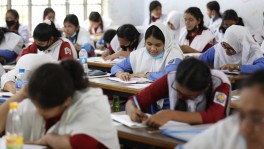Dredging rivers stressed to save Sunamganj haor crops

Besides the negligence and irregularities in the construction of dams, the crops in the haor area are damaged due to the loss of river navigability, so dredging of rivers and timely construction of sustainable dams is required, said farmers, officials and experts.
Emphasising restoring the navigability of rivers, they said that if the irregularities and negligence in dam construction are reduced, the crop will be saved to some extent, but if the onrush of upstream water is strong, the crop can no longer be protected only with dams.
Deputy Minister for Water Resources AKM Enamul Haque Shamim also talked about dredging when he visited Sunamganj on 8 April to see the loss of crops in the haor.
Sunamganj, Habiganj, Kishoreganj, Netrokona, Sylhet, Moulvibazar and Brahmanbaria districts have 414 haors covering an area of 14,536 sq km. At least 14 rivers including the Meghna, Surma, Kushiyara, Jadukata, Piain, Boulai, Katlai, Someshri, and Khowai, have flowed through these haor areas.
All these rivers have lost their navigability due to flooding. As a result, the river overflows and spreads in the surrounding areas even with low rainfall.
According to the Department of Agricultural Extension, this time boro has been planted in over 9.5 lakh hectares of land in seven haor districts. In the last few days, at least 10,000 hectares of crops have been inundated by rains and landslides.
Sunamganj has the highest number of haors in the country. So far, crops on over 5,000 hectares of land have been flooded.
Bangladesh Water Development Board Executive Engineer Md Shamsuddoha said work on the dam in haor is scheduled to start by 15 December, but the water of many haors of Sunamganj did not recede in December. This has been happening for the last few years. There was water in some parts of some haors including Halir haor and Shanir haor till January.
Kashmir Reza, president of Haor O Paribesh Unnnayan Sangtha, said the floodwater did not recede in time because sand comes with the water which decreases the navigability of the river. As a result, rivers cannot accommodate haor water. Water has been accumulating in the haor even in the dry season for the last 7-8 years.
Korunashindhu Pal, chairman of Tahirpur upazila in Sunamganj, said there are irregularities in the construction of the dam. Dams are broken in many places but in many places, water overflows the dams and enters into the haor within two days, which did not happen in the past.
Sunamganj Upazila Department of Agricultural Extension Deputy Director Bimal Chandra Shome also said that the whole river has to be dredged extensively to save crops.
Haor researcher Halimdad Khan said water used to flow into the Bay of Bengal through River Meghna in the past, but the river is full and presently water overflows into the haor. Every year water enters the haor. This water cannot be stopped by dams alone.
"We had our local varieties that could be harvested before the rains started, though the yield was less. Now the yield is higher in hybrid varieties, but it takes more time to harvest. So agricultural scientists have to invent new varieties suitable for the haors," he added.
Acknowledging the need for river dredging to protect crops, SM Shahidul Islam, additional chief engineer of Water Development Board, Sylhet Division, said, "Last year, we sent a project for river dredging worth Tk1,400 crore to the ministry. At the end of the feasibility study, it is now under consideration of the ministry."
He added that besides dredging the river, there is a need to think about how to build more sustainable dams.


 Keep updated, follow The Business Standard's Google news channel
Keep updated, follow The Business Standard's Google news channel
















